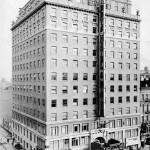Most people have heard of Martin Luther King, Jr. and all that he did to end institutionalized racism in our nation. However, few seem to know about the man behind the scenes, the chief architect of the 1963 March on Washington for Jobs & Freedom, Bayard Rustin. Our nation owes Rustin, a posthumous 2013 recipient of the Presidential Medal of Freedom, a great debt for his tireless efforts in creating a free and just society.
Rustin was a remarkable man, an African American, openly gay, Quaker, pacifist, and talented performer on stage and in nightclubs, who organized for peace, justice, racial integration, and equality. Not only did he contribute greatly to King’s Montgomery Bus Boycott, he also helped to organize an important anti-racism pilgrimage to the nation’s capital and an early voting rights effort in the 1950s. Rustin also helped organize an important march on the capital in 1941, which was canceled only when President Roosevelt signed an order granting African Americans jobs in the defense sector.
When Bayard Rustin first arrived in NYC in the late 1930s, he lived with an aunt in Harlem. Although Harlem’s heyday of the roaring twenties had ended, its intellectual, cultural, and political life still thrived, and Rustin was heavily immersed in both uptown and downtown circles. He was also involved with the Harlem Ashram, which practiced Gandhi’s principles of nonviolence. Rustin moved about extensively in Harlem, as well as Greenwich Village and its environs. In honor of Rustin’s deep ties to NYC, Martin Luther King, Jr. Day, and Black History Month, I, an historian, activist, and city planner, under the auspices of the Municipal Art Society of New York (MAS), have organized a two-part tour series that explores Bayard Rustin’s New York: “Uptown and Downtown.”
The first of these tours took place on Sunday, January 17, 2016, beginning at the 15th Street Quaker Meeting in Manhattan. Rustin was a member of this congregation and was greatly influenced by his Quaker grandmother in Westchester, Pennsylvania. Several older members of the Friends Meeting that knew Bayard Rustin spoke to the group. One member, Julie Finch, who, along with CUNY professor Fern Luskin, has valiantly led an near decade long battle to save the only verifiable underground railroad site in Manhattan (which we visited at the end of the tour), described how her father co-edited the War Resisters’ League magazine Liberation with Rustin. She reminisced about how he visited their house when she was a child and baked donuts together!
Our next stop was Mott Street in Little Italy. I discussed how Rustin and many other activists lived in the back building of the tenement at 217 Mott Street in the late 1940s after Rustin was released from prison for draft resistance. During this time, Rustin spearheaded the Journey of Reconciliation which was the first Freedom Ride, years before the famous ones of the 1960s.
Moving on to Sheridan Square, the tour visited the site of the legendary integrated club Cafe Society which Rustin considered a social paradigm: diverse in race, sexual preference, and class. We discussed Rustin’s performing career, first on Broadway with Paul Robeson in John Henry and then with Josh White and his Carolinians at Cafe Society. This was also where Billie Holiday first sang the haunting tune, Strange Fruit.
Around the corner on Christopher Street, we visited the site of the legendary Stonewall Bar Riots of 1969. We also noted preceding riots at Compton’s Cafeteria in San Francisco in 1966 and at Cooper’s Donuts in Los Angeles in 1959—both led by transgendered folks. We then paused to discuss the sit-ins held at Dewey’s Lunch Counter in Philadelphia in 1966, which were spearheaded by transgendered people of color based on Rustin and King’s Gandhian Non Violent Direct Action in the South.
The tour ended at Penn South, the large housing complex in northern Chelsea built by Rustin’s union colleagues. Both he and his mentor, union organizer and activist A. Phillip Randolph, lived their final years in the complex. In this apartment, Rustin held the first meetings to plan the 1963 March on Washington and also lived with his partner Walter Nagle, who keeps his memory and work alive. The building is across the street from the Hopper Gibbons House, where a noted Quaker Abolitionist family contributed immensely to the Underground Railroad. Thus the tour came full circle to Rustin’s origins in the Religious Society of Friends, Quakers.
Part Two of the Tour Series will take place in Harlem on Saturday, February 27, 2016 at 1:00pm. The cost is $20 for MAS members and $30 for non-members. Join me as we explore Rustin’s involvement in “The Capital of Black America” in Harlem.


